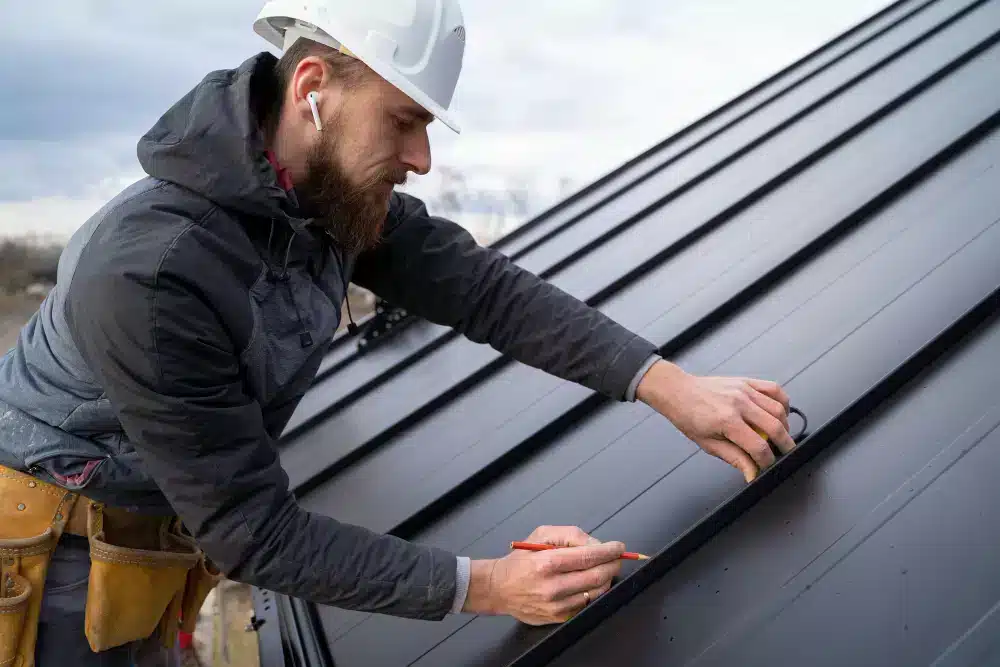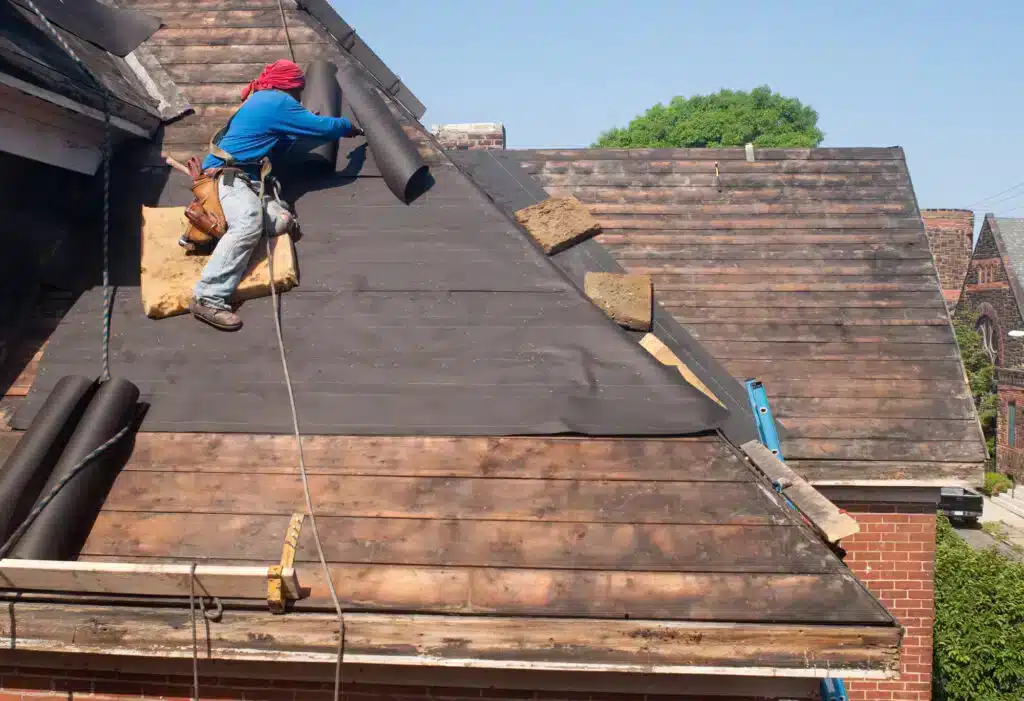Table of Contents
Let’s talk about the first line of defense when it comes to a home’s security and integrity. A reliable roof has a life span of 30-70 years, and after that, it might start showing signals that: “It’s time to upgrade.” The much-needed upgrade might make you worry about the installation costs and procedures. In this article guide, we will help you figure out the estimate on the cost of installing a new roof and starting from scratch. Get ready for an aesthetic upgrade.
For any homeowner, replacing a roof is a major expense. It’s critical that you understand the variables affecting costs and learn how to precisely project the whole expenditure.
Elements Affecting Roof Replacement Cost

Not every roof-changing project is going to cost you the same. There are several factors that can cause a roof replacement to cost dramatically different amounts. Comprehending these elements will help homeowners make well-informed decisions and allocate funds appropriately.
1. Pitch and Size of Roof
When determining how much it costs to replace a roof, the first thing to consider is the size and pitch of your house’s roof.
- Size: A major factor in learning how much is a new roof is the roof’s dimensions. Typically, squares are used to measure roofs, where one square is equivalent to 100 square feet. Greater labor and material requirements for larger roofs raise the final cost.
- Pitch: Your roofing contractor might have told you that the roof’s slope impacts the complexity of the installation. Higher labor expenses result from the increased difficulty and potential need for extra safety precautions associated with steeper roofs.
2. Selection of Roofing Materials
The next factor to consider when getting an estimate on the cost of the new roof is the materials being used. The cost is significantly influenced by the selection of roofing material. Typical materials consist of:
- Asphalt Shingles: At $100 to $200 per square, this is the most popular and least expensive alternative.
If you want details on different shingles types, here is a quick guide.
- Metal roofing: $300 to $800 per square foot; this type of roofing is long-lasting and energy efficiency focused.
- Tile Roofing: This type of roofing costs between $600 and $1,000 per square foot and has a distinctive appearance.
- Wood Shingles: It costs between $400 and $700 per square foot and offers a natural appearance.
- Slate Roofing: It is the most expensive alternative, costing between $800 and $1,600 per square, but it is very long-lasting and attractive. You can make an informed decision by calculating the cost per roofing square for every material and then picking out the best.
3. Roof Complexity
Costs might be impacted by the roofing system’s architectural complexity. Dormers, numerous valleys, and sophisticated patterns all need extra labor and materials on the roof, which raises the total cost.
4. Location
The cost of materials and labor can vary by region. Compared to rural areas, roofing expenses are generally greater in urban areas or high-cost locations. Homeowners can more precisely compare these expenses with a roofing cost calculator.
5. Old Roof Removal
The cost of labor increases if the old roof needs to be removed before a new one is installed. The cost of the removal procedure varies based on the roof’s accessibility and complexity, ranging from $1 to $5 per square foot. Budgeting for a new roof heavily depends on the average cost of tearing it off and replacing it.
6. Inspections and Permits for Full Roof Replacement
Getting the required inspections and permissions is crucial for roof replacement operations. Location-specific permit fees vary, but they often fall between $150 and $500. Homeowners can save time and work by handling these details by hiring a roofing company.
7. Contractor Experience and Warranties
Selecting a reliable roofing contractor with experience and a strong guarantee can influence the cost. Although they may need a larger initial outlay, longer warranties, and better craftsmanship can save money over the long term.
Estimate on Cost Breakdown for New Roof

Below is an estimate of typical expenses related to roof replacement:
| Aspect | Average Cost |
| Size | $100 – $1,600 per square |
| Material | Varies |
| Labor | $1.50 – $3.00 per sq ft |
| Old Roof Removal | $1 – $5 per sq ft |
| Permits | $150 – $500 |
It is pertinent to mention that the estimates can differ for particular jobs, such as the cost of replacing a garage roof. An expert’s roof replacement quote might offer a more customized price.
In this article, you can check details on additional costs when replacing the roof.
Complete vs. Partial Roof Replacement
The condition and damage of the current roof and financial constraints determine whether to replace the entire roof or only a portion of it.
Complete Roof Replacement
A complete roof replacement entails taking off the entire old roof and replacing it with a new one.
This choice is best when:
- The roof’s practical lifespan is almost over.
- There are common issues like large-scale damage or leakage.
- You wish to replace your roof with one that is stronger or more energy-efficient.
A complete replacement guarantees consistency in both performance and look, giving your house long-term protection. However, the roof estimate cost could begin out higher.
Replacement of a Partial Roof
Just a portion of the roof needs to be replaced in a partial replacement.
This choice is appropriate in the following situations:
- Damage is specific to one area, as it is after a storm
- Complete repair is not possible due to financial limitations.
- The current roof is in acceptable condition and is not too old.
Even if a partial replacement initially costs less, it could not be as long-lasting and durable as a full replacement.
Signs to Get a New Roof
It can help to stop additional damage and expensive repairs by recognizing the indicators that your roof needs to be replaced.
1. Age of the Roof
The majority of roofing materials last between 20 and 30 years. It might be time for a replacement if your roof is getting older or has already passed this point.
2. Visible Damage
Look for obvious signs of damage on your roof, such as drooping sections, curling edges, or missing or broken shingles. These problems might weaken the roof’s structure and cause leaks. If it is seriously damaged, the roof needs to be repaired or replaced.
3. Stained and Leaking Water
Water stains on walls or ceilings are a dead giveaway for roof leaks. Ignoring these indicators could result in substantial mold growth and water damage, which would increase repair costs.
4. Granule Loss
It is noteworthy that the granules from asphalt shingles frequently fall off over time and gather in gutters. Aging and weakened resistance to the environment are indicated by excessive granule loss.
5. Higher Energy Costs
Poor insulation and ventilation brought on by a decaying roof might result in higher energy bills because of the increased expense of heating and cooling.
Conclusion
Coming to the end of this discussion, it is wise to go through the expense guide when thinking of replacing your old damaged roof with a new one. From knowing the cost of roofing materials to consulting with an experienced roofing contractor, each step guarantees a safe roof installation. So, read our article guide to get estimates on new roofs and change the look of your home.
